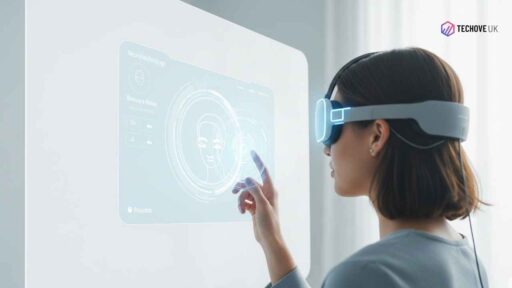Introduction: The Fascination with the Human Decoding the Mind
Welcome to Techove UK. We can write our amazing content experiment about A Decoding the Mind: Astonishing Neuro Tech Discoveries Revealed with powerful details and information.
The human mind has always been a source of wonder, mystery, and endless curiosity. From ancient philosophers pondering the nature of thought to modern scientists exploring the depths of brain activity, understanding how the mind works has been one of humanity’s greatest quests. Today, thanks to groundbreaking advancements in Neuro Tech, we are closer than ever to decoding the secrets of the human brain. Imagine being able to predict what someone is thinking or understanding why they make certain decisions—this is no longer just science fiction but an emerging reality.
In this article, we’ll dive into some astonishing discoveries in brain decoding, explore how artificial intelligence (AI) is reshaping our understanding of the new consumer mind, and discuss how these technologies transform fields like marketing, healthcare, and beyond. So buckle up as we embark on this fascinating journey into Neuromarketing, decoding the mind, and cutting-edge neuroscience.
What Is Neuro Tech? A Gateway to Decoding the Mind
Before diving into specific discoveries, let’s first understand what Neuro Tech actually means. At its core, Neuro Tech refers to technologies designed to study and interact with the nervous system—especially the brain. These tools allow scientists to monitor brain activity, decode neural signals, and influence mental processes.
One example is functional magnetic resonance imaging (fMRI), which measures blood flow in different brain parts to identify areas activated during specific tasks. Another popular tool is electroencephalography (EEG), which records electrical activity in the brain through sensors placed on a person’s scalp. These technologies have paved the way for incredible medical, educational, and even marketing breakthroughs.
But perhaps most excitingly, Neuro Tech has opened up new possibilities for “decoding the mind” not in a magical sense but through scientific methods that analyze patterns in neural data. This brings us closer than ever to truly understanding how thoughts form and decisions are made.
The Role of Artificial Intelligence in Decoding Your Brain
When interpreting complex neural data, humans alone can’t do it all. This is where artificial intelligence (AI) steps in as a game-changer. AI algorithms can process vast amounts of information from tools like EEG or fMRI far more quickly and accurately than any human could.
For instance, researchers have developed AI systems that identify emotions based on subtle changes in brainwave patterns. These systems can distinguish between happiness, sadness, anger, or excitement—all without needing verbal input from a person! This ability has profound implications for industries like customer service or mental health care.
In marketing specifically, what we now call Neuromarketing, AI-powered tools analyze consumers’ subconscious reactions to advertisements or products by studying their brainwaves. Companies can then tailor their strategies based on these insights to better connect with their audience emotionally.
As Kit Yarrow, a renowned psychologist specializing in consumer behavior, once said, “Understanding what drives people at a subconscious level is key to creating meaningful connections.” With AI and Neurotech working hand-in-hand, businesses can tap into this hidden layer of human decision-making like never before.
Neuromarketing: Unlocking the New Consumer Mind
Speaking of marketing innovations, let’s talk about neuromarketing, a field that combines neuroscience and traditional marketing techniques. The goal? To understand how customers think and feel when exposed to various stimuli such as advertisements or product designs.
Traditional market research methods like surveys often rely on self-reported data, which isn’t always reliable because people may not fully understand their own preferences or might give socially desirable answers instead of honest ones. Neuromarketing bypasses this issue by directly measuring physiological responses such as heart rate changes or pupil dilation alongside neural signals from devices like EEGs.
For example:
- A company might test multiple versions of an ad campaign while monitoring participants’ brain responses.
- Marketers can choose the most effective option by analyzing which version elicits stronger emotional engagement (as indicated by increased beta waves).
- Similarly, eye-tracking technology combined with EEG can reveal which parts of an ad capture attention most effectively.
This approach allows businesses to predict consumer behavior more accurately and foster deeper emotional connections between brands and their audiences, a crucial factor in today’s competitive marketplace dominated by short attention spans!
Case Study: Neuromarketing and the New Consumer Mind
Let’s dive into a real-world example of how neurotech is getting used to decoding the mind.
The Challenge
Companies consistently seek to understand what drives customer behavior. Traditional methods like surveys and focus groups provide some insights, but they often fail to uncover the true motivations behind customer actions.
The Solution
Neuromarketing is a field that utilizes neurotechnology to explore customer thoughts. By analyzing brain activity, organizations can better understand what drives customer decisions.
The Results
One of the pioneers in this field is Kit Yarrow, a customer psychologist who has utilized neurotechnology to uncover surprising insights into human thought processes. For example, her research has shown that emotions significantly influence purchasing decisions, more than previously believed.
This is an example of how Decoding the Mind through marvelous neurotechnology discoveries reshapes industries and changes our perspective on the human brain.
👉Related Post: Pioneering Neuro Tech for Seamless Human-AI Collaboration (Case Study)
How Brain Decoding Works: Peering Into Thoughts
Now let’s get into one of the most jaw-dropping aspects of Neuro Tech: brain decoding. Imagine reconstructing images someone has seen by analyzing their brain activity or predicting what word they’re about to say based on neural patterns! While this might sound straight out of a sci-fi movie plotline, it’s happening now thanks to advances in neuroscience combined with machine learning algorithms.
Here’s how it works:
- Neural signals generated during specific activities (e.g., looking at pictures) are recorded using tools like fMRI.
- These signals are fed into AI models trained on large datasets linking certain patterns with corresponding stimuli.
- Over time—and after processing millions upon millions of data points—the model learns enough correlations between inputs (neural data) & outputs (images/words/emotions) that it becomes capable of recognizing them and predicting future occurrences too!
- In Japan, scientists used AI models and fMRI scans to recreate images people imagined inside their heads!
- Researchers at UC Berkeley successfully reconstructed video clips people watched by analyzing their visual cortex activity.
One famous experiment involved showing participants images while scanning their brains via fMRI; later, researchers reconstructed those visuals purely based on recorded neural signatures!
Ethical Dilemmas: Should We Be Concerned?
As exciting as these advancements sound, there is reason for caution. Imagine living in a world where companies could read your thoughts without consent, or where governments use neurotechnology tools for surveillance purposes.
Ethical concerns surrounding privacy rights loom large over fields like neuromarketing & brain decoding:
- Who owns the neural data collected during experiments?
- How do we ensure informed consent when participants may not fully grasp the implications?
- Could such technologies exacerbate existing inequalities between those who can afford access vs those left behind?
Collaboration among global policymakers and researchers developing these tools will be essential to balance innovation with ethical considerations. They must operate under strict guidelines that ensure transparency, accountability, fairness, and more.
Artificial Intelligence Meets Neuro Tech
Modern neuroscience cannot be discussed without noting its partnership with AI, which is revolutionizing diagnostics, treatments, and therapies.
AI excels at processing, analyzing, and interpreting enormous datasets generated by neuroimaging machines, enabling researchers to identify subtle correlations that were previously overlooked by manual methods alone.
IBM Watson Health utilizes cognitive computing to assist doctors in diagnosing neurological disorders like Alzheimer’s, Parkinson’s, and epilepsy at earlier stages, significantly improving patient outcomes.
Startups are exploring wearable devices powered by neural networks that can predict emotional states in real time. These devices provide personalized recommendations tailored to individual preferences, needs, and desires, seamlessly integrating into daily lives and exponentially enhancing the overall quality of existence.
FAQs About Neuro Tech
1. What is brain decoding?
Brain deciphering is the method of decoding the brain activity, decoding the mind, feelings, or actions.
2. How does neuromarketing work?
Neuromarketing uses neurotech to examine mind interest and gain insights into consumer behavior.
3. Can neuro tech read minds?
While neuro tech can’t study minds within the traditional experience, it could interpret mind signals to anticipate thoughts or movements.
4. Is neuro tech safe?
Yes, neuro tech devices undergo rigorous testing to ensure they’re safe and effective for customers.
5. What’s next for neuro tech?
The future of neurotech involves more advanced decoding the mind, AI integration, and new packages in healthcare, advertising, and the past.
Conclusion
The marvelous discoveries in Decoding the Mind thoughts: The marvelous neurotech discoveries are a testament to human ingenuity and the generation’s energy. From understanding brand-new customer thoughts to developing thought-studying technology, neurotech is changing the sector in ways we once thought impossible.
As we appear to the destiny, the capability of neuro tech is limitless. Whether through groundbreaking decoding of the mind, AI-pushed treatments, or progressive packages in marketing and healthcare, one thing is apparent: the future of neuro tech is here, and it’s more interesting than ever.
So, the next time you hear about neuro tech, remember it’s not just technology fiction. It’s a technological know-how fact, and it shapes today’s arena.





